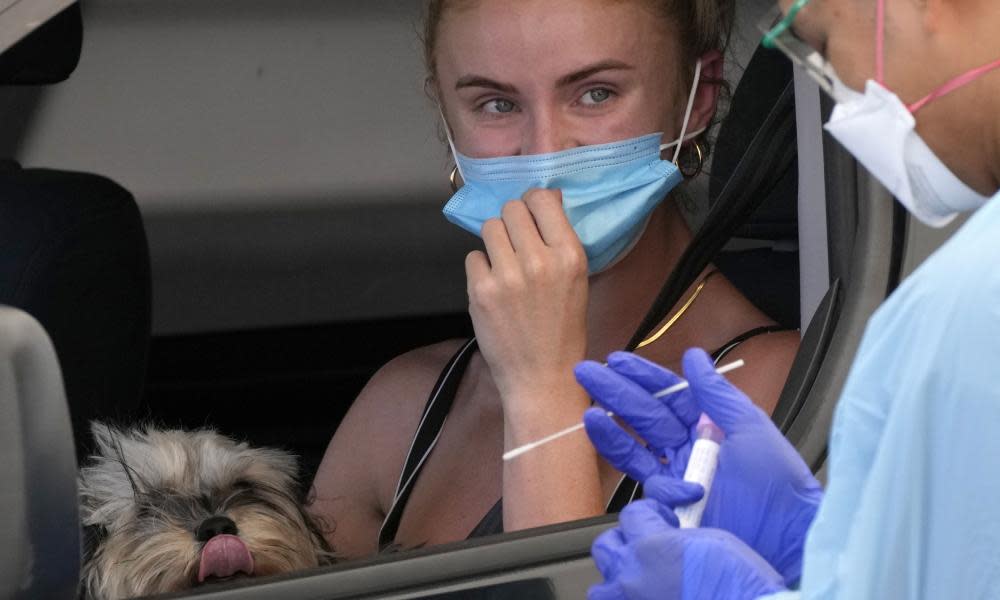Australia’s Omicron wave has likely peaked in NSW and Victoria, some experts say

Scientists say hardest-hit states are ‘probably through the worst’ as cases are ‘levelling off’
The Omicron outbreak of Covid cases appears to have peaked in New South Wales, Victoria and other parts of Australia, epidemiologists believe.
Prof Adrian Esterman, an epidemiologist and biostatistician at the University of South Australia, said the Omicron wave had “absolutely certainly” peaked in NSW and Victoria.
The Reff – the effective reproduction number, which measures how many other people someone with Covid will infect, on average – had dropped below 1 in both states, Esterman said.
“We know that the peak has been reached when the Reff gets below 1.”
On Thursday, Esterman calculated the Reff to be 0.83 in NSW and 0.8 in Victoria.
Related: ‘A lot of anxiety’: childcare centres and parents warn of trouble ahead as Covid spreads
“You can’t really interpret the daily cases very well because of huge fluctuations and large of numbers of rapid antigen tests coming through on a given day but being distributed over previous days,” Esterman said. “The Reff is still reasonably stable despite the daily fluctuation in case numbers.”
Victoria’s chief health officer, Brett Sutton, said on Monday he believed the state’s case numbers were close to peaking, but expected the number of people in hospital would continue to increase.
The number of people in hospital with Covid in NSW dropped on Thursday to 2,781, the first time the figure has fallen in the state since 18 December. The state’s health authorities had previously predicted that hospitalisation figures – which typically lag reported case numbers by seven to 14 days – would begin to plateau this week.
“I would expect to see hospitalisations starting to come down now,” Esterman said.
Other experts were more cautious. Dr Michael Lydeamore, an infectious disease modeller at Monash University, said NSW was “probably through the worst” and that Victorian cases looked to be “levelling off”, but that it would take another week before experts could be certain both states had reached a peak.
“NSW looks more like it’s peaked than Victoria, but in both states we’re still not really sure how many infections we’re detecting. It’s that separation between infections going on and cases, which is what’s reported,” he said.
Prof Alexandra Martiniuk, an epidemiologist at the University of Sydney agreed that while cases seemed to be dropping in NSW, “the lack of good data is making this hard”.
Despite the welcome inclusion of positive RATs in official case figures, “we don’t have an accurate sense of the number of cases in the community”, she said.
Experts agree that population-wide surveys are needed to accurately estimate levels of Covid infection in Australia.
Esterman said Covid spread was showing “a very similar pattern across all states and territories” except Western Australia, “likely peaking at the moment and almost certainly going to be coming down shortly”.
Lydeamore anticipated a “bumpy road” ahead for the Northern Territory over the next few weeks, due to lower vaccination rates in some regions, high rates of pre-existing health conditions, and challenges posed by geographical remoteness. “That’s going to make it very tough,” he said.
Though Omicron cases have risen steeply, experts said the decrease in cases was likely to occur more slowly.
“We could be having high cases for a while as it drops slowly down, and it could also plateau at a level that is not necessarily low,” Martiniuk said.
Other countries, such as Canada, experienced a slight uptick in Covid cases when students returned to school, she said.
Esterman anticipated a “slow decline in case numbers with an occasional blip upwards when things happen, like schools reopening”.
Lydeamore said while school-related outbreaks and infections among teaching staff were likely, the return to school was “probably not going to massively blow up the cases again”.
Martiniuk emphasised the importance of getting boosters, wearing masks and outdoor socialising “while we’re dropping down the curve”.
“Sadly, this isn’t the end of Covid, probably.”

 Yahoo News
Yahoo News 
